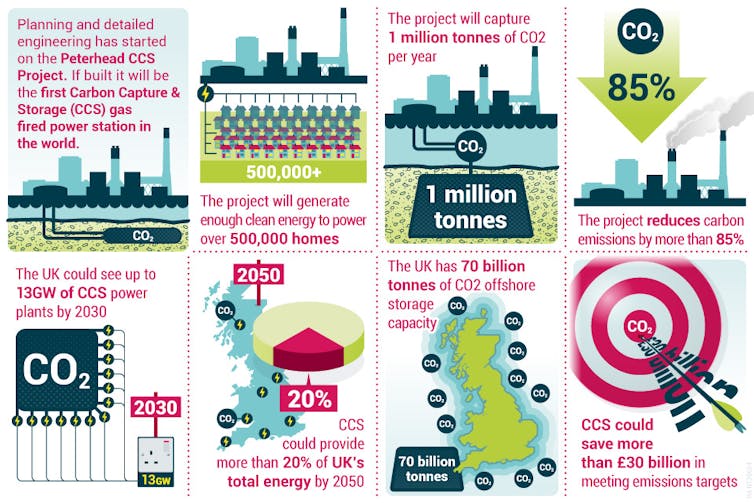Despite the evidence that shows greenhouse gases from burning fossil fuels are leading to changes in the planet’s climate, the development of large scale technologies to slow or stop these effects has been painfully slow.
None more so than carbon capture and storage (CCS), the technology to extract CO2 from the exhaust gases of power stations, or from industrial processes such as cement, steel, fertiliser, petrochemicals and paper manufacturing, and bury it in porous rocks deep underground.
But now the UK government has pledged £50m towards CCS at Peterhead gas power station in northeast Scotland. A joint venture between Shell and power company SSE, it is intended to become the world’s first CCS system attached to a gas power station, and would store CO2 in the depleted Goldeneye gas field 60 miles offshore.
It is now the second CCS scheme to get recent UK government funding – the first, the White Rose CCS scheme at the Drax coal- and biomass-fired power station in Yorkshire, Britain’s largest power station, won a similar part of a total £100m investment in December last year. That these two projects are underway is the culmination of more than 10 years’ effort from industry, government, and academic research.
While this is a unique industrial and energy engineering selling point for the UK, a compilation of CCS projects worldwide reveals that, at the most optimistic, only 21 projects are operating or under construction. This is considerably behind the schedule proposed by the International Energy Agency of more than 100. A common problem preventing wider roll-out of CCS is the perceived high costs of construction and operation, compared to running power plant without any measures to reduce CO2, despite numerous studies demonstrating that cleaning up emissions without CCS will be much more expensive, and slower to achieve.

A major failure of governments and international bodies is the lack of binding CO2 emissions reduction targets. Even in Europe, the most climate-conscious of all the major trading blocs, the proposed Strategic Energy Plan for 2030 leaves CCS as an “option” to be “explored” by member states, which then, by a mysterious process yet to be invented, will contribute towards meeting the EU’s stated carbon reduction target.
All this translates as “lack of business model” – a polite way of saying that no sensible company would commit to CCS for many years yet, until government policy is sufficiently stable to safeguard their investment of time and money. What is needed is clarity and commitment from many governments in parallel – at the same level that has fostered the development of the renewable energy industry. But that means confronting Treasury, businesses and consumers with the unpopular news that their payments for electricity and heat must eventually rise by 15%.
UK should be leading
The British Isles are uniquely well placed to develop CCS: electricity generation is dominated by just six large power companies which the government should be able to influence, and there is an active, innovative engineering sector. Best of all, the British Isles are surrounded by some of the most extensive and best-known geological reservoirs to store CO2, with the expertise and technologies to develop these readily available within the North Sea offshore oil and gas workforce.
But there have been a series of false starts. The first was a proposition from BP for a CCS at the Peterhead power plant using the Miller oil field for storage, which would have produced low-carbon electricity at less than the subsidies awarded to offshore wind farms today. It was rejected by the UK government in 2005. In 2007, the government opened the first UK CCS competition to bidders for funding. Eventually, the only remaining project was Scottish Power’s proposal for Longannet power station, but this was also scrapped in 2011 when the Treasury decided the extra £200m it would have cost was too expensive – despite receiving a record £11 billion of North Sea oil and gas tax revenue that year.
This second, much more carefully controlled, competition was opened in 2012 and is now bearing fruit. The projects at Drax and Peterhead now enter an 18-month phase of technical, engineering, and financial design. Final decisions are not due before late 2015, and so will inevitably be complicated by the UK’s general election. At the most optimistic reading, CO2 could be injected into storage during late 2018.
Spreading the technology
But these are just two experiments, to demonstrate that known technologies can work practically at a large scale – three other power plant projects have also been proposed, but are un-funded. To achieve sufficient de-carbonisation to make an impact on the UK’s 2030 carbon budget another 20 CCS projects will be needed. However, these three projects offer a different twist on the technology, by injecting the captured CO2 into depleted offshore oilfields to extract oil that would otherwise be left underground. Estimates of how much this would raise production rates range from 5% to 20%. Our research at SCCS shows this is feasible and can even be configured to store more CO2 than is produced by the extra oil. A useful side effect is a further £200 billion of oil tax revenue brought to the UK exchequer.
But this needs joined-up co-operation, as demanded by Sir Ian Wood’s review of the North Sea oilfields, and is complicated by issues of ownership between the UK and Scottish governments, with the independence referendum looming. If the UK is serious about using CCS, then bringing these follow-on projects to commercial realisation is the single most urgent item to tackle, now that the first two grant-funded projects are on their path.
The UK has the engineering skills, the technology, and plentiful storage sites, supported by skilled civil servants, regulations, and a unique financial package through the government’s contracts-for-difference that offer higher prices to low-carbon power generators. Whether CCS emerges from pilot projects to widely deployed industrial reality depends on the political priorities, courage and credibility of this government, and the next.

